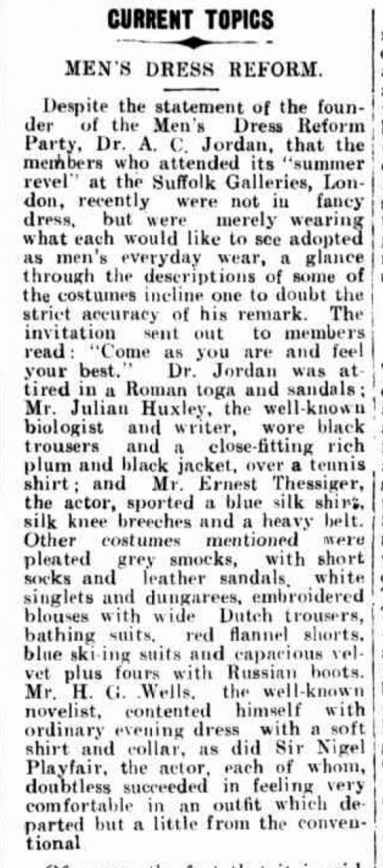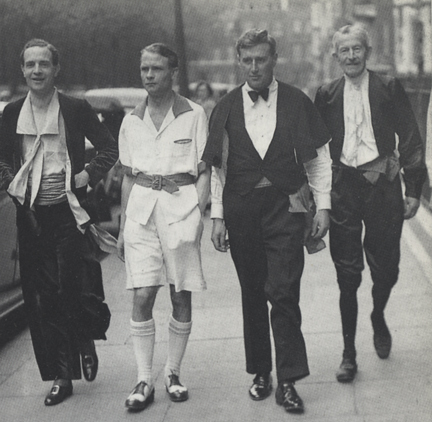Members of the Men's Dress Reform Party, 1937.
Here’s a party whose caucus I’d love to watch: The Men’s Dress Reform Party. While researching the history of men and makeup, I ran across a mention of this odd-duck British party in the 1930s whose sole purpose was to agitate for loosened clothing restrictions on men. They paraded about in shorts, open-collared shirts, and color-coordinated socks; if a member wore a tie, he might fasten it inches below his Adam’s apple.
The idea was that the dark, heavy clothes men were expected to wear were unhygienic (it was difficult to wash a suit before widely available dry cleaning—indeed, that’s part of why suits are traditionally dark, to mask dirt), and ugly to boot (we’ll get to that). Men’s clothing was a health hazard, they claimed, which fell into line with its parent organization, The New Health Society, a group devoted to educating people about nutrition, “intestinal stasis,” and “helio-hygiene.” (I visualize them as a predecessor to Gwyneth’s Goop team.) So they fought back, urging employers to let workers wear freer dress, organizing ersatz holidays in which men were to wear whatever they pleased, and throwing rallies at which members were instructed to “Come as you are and feel your best,” which for some meant togas, for others singlets and jeans, and for H.G. Wells, meant “ordinary evening dress.”

Western Argus, Kalgoorlie, Australia, July 14, 1931
It seems odd at first that this would be an organized group instead of a looser assemblage, but its goals were political. They’d seen how women had begun to fling off repressive roles, a movement reflected in their clothes; why not do the same for masculinity? J.C. Flügel, an influential psychologist at the time and a proud MDRP member, claimed that the institutionalization of the suit had led to a “a remarkable repression of Narcissism among men,” which he saw as undesirable, as it left all the fun of self-ornamentation to women. Unleashing men’s sartorial fancy, he argued, would loosen their superego, the restrictive, repressive force in the human psyche—which would ultimately lead to greater freedom.
What’s interesting about the MDRP is its split between a vision that even today seems progressive (a lessened emphasis on traditional masculinity) and a cause that seems abhorrent. Part of the MDRP’s cause revolved around eugenics: If the “right” men were to showcase their appearance, they would be more attractive to the “right” women, and more “right” babies (that is, white babies born into the professional class) would be created. Eugenics was widely accepted in mainstream science and medicine then, but even contextualized, it’s clearly troublesome for all sorts of reasons, with fascism topping the list. Yet even within this odious framework, I appreciate their commitment to at least thinking through the evolutionary logistics. Evolution is often cited as a reason women wear makeup: It’s ornamentation that catches the eye of potential mates. It’s a perfectly fine theory until you question why it’s women, and not men, who wear makeup (for the most part), when both sexes have an evolutionary need to attract the other. So the MDRP’s eugenics mission was wrongheaded, but at least it bothered to beconsistent with its own internal logic and wasn’t just cherry-picking its theories to justify a sexist vision.
Eugenics is tied to class, not just race, and the MDRP has an interesting fabric here too. The party claimed to be for people of all classes, but the fact was that most of its members were middle- and upper-class, and that they weren’t advocating for more accessible clothes, but more fashionable ones. (In fact, clothes were about to become way more accessible, with the invention of fabrics that invited ready-to-wear clothes—which actually wound up accomplishing the MDRP’s goals, even though they had nothing to do with it.) But the MDRP’s biggest reinforcement of class is something that’s familiar today. The suit that the MDRP was fighting against was the very thing their grandfathers had fought for: a uniform of sorts that would theoretically allow for meritocracy to flourish, since it was more difficult to display wealth through the suit as opposed to the ruffles of the aristocracy. The ruffles were seen as oppressive; eventually, the suit that replaced it became seen as the same.
Today it would look like the MDRP’s vision has won out, at least in America (though remember, the MDRP was British) with leisurewear accepted in plenty of professional workplaces and shorts no longer seen as the province of little boys. But the suit remains, and it remains as a symbol of class. Most of the time I see a man in a suit, he’s either in the upper echelons of certain professional worlds (financiers, government officials), or he’s in a position of servitude (security, hospitality). By agitating for the loss of the suit, the Men’s Dress Reform Party wanted to revert to the days of male self-ornamentation as a display of cultural capital. The suit remains, albeit changed—and changed in a way that has shifted its meaning to be about a display of, not an eradication of, cultural capital. In that way, regardless of the MDRP’s place as a mere footnote in history, they were unexpectedly successful.
